Photo
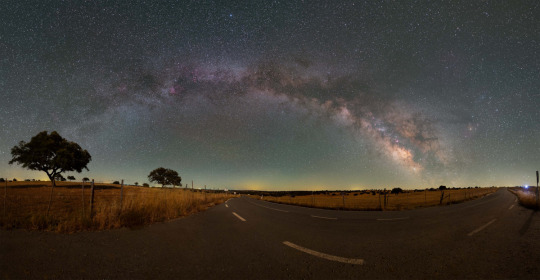
The Road and the Milky Way via NASA https://ift.tt/4az8T0h
At night you can follow this road as it passes through the Dark Sky Alqueva reserve not too far from Alentejo, Portugal. Or you could stop, look up, and follow the Milky Way through the sky. Both stretch from horizon to horizon in this 180 degree panorama recorded on June 3. Our galaxy's name, the Milky Way, does refer to its appearance as a milky path in the sky. The word galaxy itself derives from the Greek for milk. From our fair planet the arc of the Milky Way is most easily visible on moonless nights from dark sky areas, though not quite so bright or colorful as in this image. The glowing celestial band is due to the collective light of myriad stars along the galactic plane too faint to be distinguished individually. The diffuse starlight is cut by dark swaths of the galaxy's obscuring interstellar dust clouds. Standing above the Milky Way arc near the top of this panoramic nightscape is bright star Vega, with the galaxy's central bulge near the horizon at the right.
(Published June 11, 2022)
18 notes
·
View notes
Link
NASA is targeting Saturday, June 18, for the beginning of the next wet dress rehearsal test of the agency’s Space Launch System (SLS) rocket and Orion spacecraft at the Kennedy Space Center in Florida with tanking operations on Monday, June 20.
5 notes
·
View notes
Photo

M51: The Whirlpool Galaxy : Find the Big Dipper and follow the...
25 notes
·
View notes
Link
NASA’s Minority University Education and Research Program (MUREP) Innovation and Tech Transfer Idea Competition (MITTIC), a Shark Tank-style competition for students at minority-serving institutions, is officially included in the 2022 historically Black colleges and universities (HBCU) Scholar Recognition Program.
1 note
·
View note
Photo

Arp 286: Trio in Virgo via NASA https://ift.tt/h0w3qnP
This colorful telescopic field of view features a trio of interacting galaxies almost 90 million light-years away, toward the constellation Virgo. On the right two spiky, foreground Milky Way stars echo the extragalactic hues, a reminder that stars in our own galaxy are like those in distant island universes. With sweeping spiral arms and obscuring dust lanes, the dominant member of the trio, NGC 5566, is enormous, about 150,000 light-years across. Just above it lies smaller, bluish NGC 5569. Near center a third galaxy, NGC 5560, is apparently stretched and distorted by its interaction with massive NGC 5566. The trio is also included in Halton Arp's 1966 Atlas of Peculiar Galaxies as Arp 286. Of course, such cosmic interactions are now appreciated as part of the evolution of galaxies.
(Published June 10, 2022)
21 notes
·
View notes
Link
NASA and Astra Space are targeting no earlier than Sunday, June 12, for the first launch of NASA's Time-Resolved Observations of Precipitation structure and storm Intensity with a Constellation of Smallsats (TROPICS) mission.
0 notes
Photo
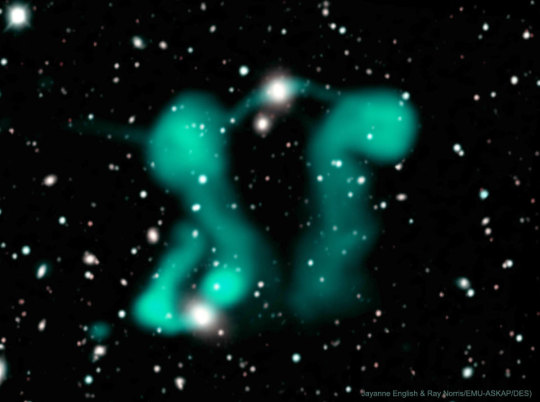
Dancing Ghosts: Curved Jets from Active Galaxies : Why...
15 notes
·
View notes
Link
NASA will host a media teleconference at 1 p.m. EDT today – Thursday, June 9 – to discuss a new study team the agency is commissioning to examine unidentified aerial phenomena (UAPs).
2 notes
·
View notes
Photo

Cosmic Clouds in Cygnus via NASA https://ift.tt/vlK2Hjq
These cosmic clouds of gas and dust drift through rich star fields along the plane of our Milky Way Galaxy toward the high flying constellation Cygnus. They're too faint to be seen with the unaided eye though, even on a clear, dark night. Image data from a camera and telephoto lens using narrowband filters was used to construct this 10 degree wide field of view. The deep mosaic reveals a region that includes star forming dust clouds seen in silhouette against the characteristic glow of atomic hydrogen and oxygen gas. NGC 6888 is the standout emission nebula near the top. Blown by winds from an massive Wolf-Rayet star it's about 25 light-years across and known as the Crescent Nebula. A faint bluish curl just below center in the frame is also the signature of a Wolf-Rayet star. Burning fuel at a prodigious rate and near the end of their stellar lives, both stars will ultimately go out with a bang in a spectacular supernova explosion. Toward the right, a massive, young O type star powers the glow of Sh2-101, the Tulip Nebula.
(Published June 09, 2022)
13 notes
·
View notes
Photo
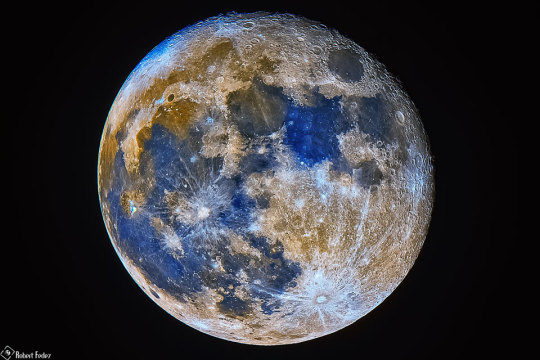
A Blue Moon in Exaggerated Colors : The Moon is normally...
11 notes
·
View notes
Link
NASA Administrator Bill Nelson helped hand out food with an extra serving of STEM activities to children and families at New Beginnings Church – The Gathering Place in Orlando, Florida, on Friday, June 3.
2 notes
·
View notes
Link
NASA Administrator Bill Nelson and Deputy Administrator Pam Melroy will travel to Noordwijk, Netherlands, to participate in the ESA (European Space Agency) Council Meeting on Wednesday, June 15.
4 notes
·
View notes
Link
NASA and the Federal Emergency Management Agency (FEMA) have released a guide which provides resources for adapting to and mitigating impacts of climate change.
2 notes
·
View notes
Photo
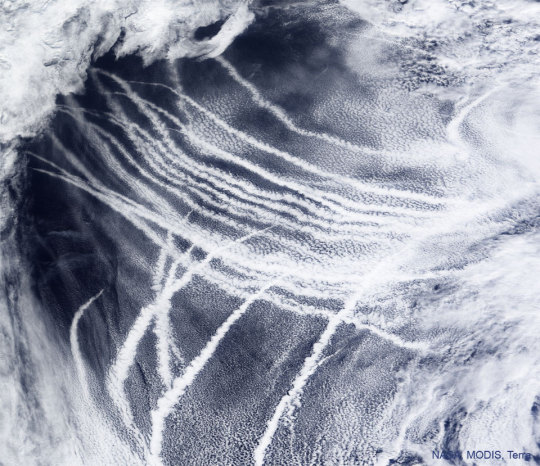
Ship Tracks over the Pacific Ocean via NASA https://ift.tt/B28mNyM
What are those unusual streaks? Some images of planet Earth show clear bright streaks that follow the paths of ships. Known as ship tracks, these low and narrow bands are caused by the ship's engine exhaust. Water vapor condenses around small bits of exhaust known as aerosols, which soon grow into floating water drops that efficiently reflect sunlight. Ship tracks were first discovered in 1965 in Earth images taken by NASA's TIROS satellites. Multiple ship tracks are visible across the featured image that was captured in 2009 over the Pacific Ocean by the MODIS instrument on NASA's Terra satellite. Inspired by ship-tracks, some scientists have suggested deploying a network of floating buoys in the worlds' oceans that spray salt-aerosol containing sea-water into the air so that, with the help of the wind, streams of sunlight-reflecting clouds would also form. Why do this? These human-made clouds could reflect so much sunlight they might help fight global warming.
(Published June 08, 2022)
6 notes
·
View notes
Photo
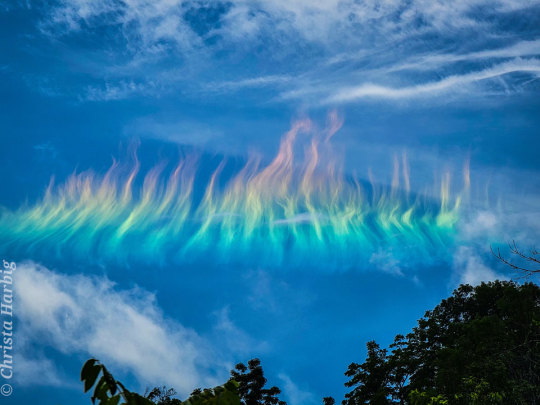
A Fire Rainbow over West Virginia : What’s happening...
14 notes
·
View notes
Link
NASA is inviting media to see a technology that could one day help land humans on Mars after it is inflated for the final time on Earth before its spaceflight demonstration later this year.
1 note
·
View note
Photo
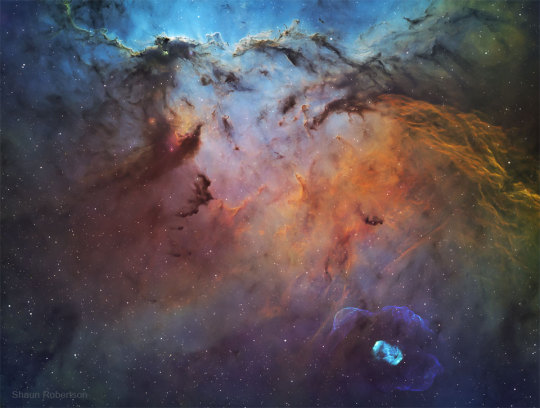
NGC 6188: Dragons of Ara via NASA https://ift.tt/SZefPd6
Do dragons fight on the altar of the sky? Although it might appear that way, these dragons are illusions made of thin gas and dust. The emission nebula NGC 6188, home to the glowing clouds, is found about 4,000 light years away near the edge of a large molecular cloud unseen at visible wavelengths, in the southern constellation Ara (the Altar). Massive, young stars of the embedded Ara OB1 association were formed in that region only a few million years ago, sculpting the dark shapes and powering the nebular glow with stellar winds and intense ultraviolet radiation. The recent star formation itself was likely triggered by winds and supernova explosions, from previous generations of massive stars, that swept up and compressed the molecular gas. Joining NGC 6188 on this cosmic canvas, visible toward the lower right, is rare emission nebula NGC 6164, also created by one of the region's massive O-type stars. Similar in appearance to many planetary nebulae, NGC 6164's striking, symmetric gaseous shroud and faint halo surround its bright central star near the bottom edge. This impressively wide field of view spans over 2 degrees (four full Moons), corresponding to over 150 light years at the estimated distance of NGC 6188.
(Published June 07, 2022)
27 notes
·
View notes